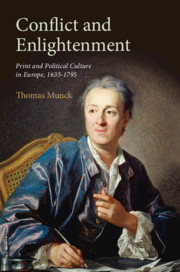Book contents
- Conflict and Enlightenment
- Conflict and Enlightenment
- Copyright page
- Contents
- Figures
- Acknowledgements
- Introduction
- 1 Print, Production, Authors and Readers
- 2 Instability and Politicisation (1630–77)
- 3 Subversive Print in the Early Enlightenment
- 4 Translation and Transmission across Cultural Borders
- 5 High Enlightenment, Political Texts and Reform 1748–89
- 6 Revolution: Democracy and Loyalism in Print 1789–95
- Conclusions
- Select Bibliography (Works Published after 1800)
- Index
5 - High Enlightenment, Political Texts and Reform 1748–89
Published online by Cambridge University Press: 21 October 2019
- Conflict and Enlightenment
- Conflict and Enlightenment
- Copyright page
- Contents
- Figures
- Acknowledgements
- Introduction
- 1 Print, Production, Authors and Readers
- 2 Instability and Politicisation (1630–77)
- 3 Subversive Print in the Early Enlightenment
- 4 Translation and Transmission across Cultural Borders
- 5 High Enlightenment, Political Texts and Reform 1748–89
- 6 Revolution: Democracy and Loyalism in Print 1789–95
- Conclusions
- Select Bibliography (Works Published after 1800)
- Index
Summary
The last two chapters of the book focus on the growing recognition that public opinion was not necessarily a political problem, but could be cultivated and harnessed by governments themselves, sometimes for mutual benefit. During the forty years before the outbreak of revolution in France, a remarkable range of major publications pushed public debate and political controversy in several different directions. Historians no longer assume the Enlightenment was anything like a cohesive programme. That conclusion is confirmed by the huge diversity of new publications on a number of key issues including censorship itself, political representation, reform of the judiciary and of taxation, economic improvement, poor relief and many other issues affecting civic society. The American Revolution created greater political awareness in Europe and pitted both the French and the British governments against critics from within. Newspapers, pamphlets, detailed reform proposals and even publication of state-sponsored information ensured that the depth and analytical power of many new texts greatly enhanced the levels of public debate in parts of Europe.
- Type
- Chapter
- Information
- Conflict and EnlightenmentPrint and Political Culture in Europe, 1635–1795, pp. 225 - 283Publisher: Cambridge University PressPrint publication year: 2019

